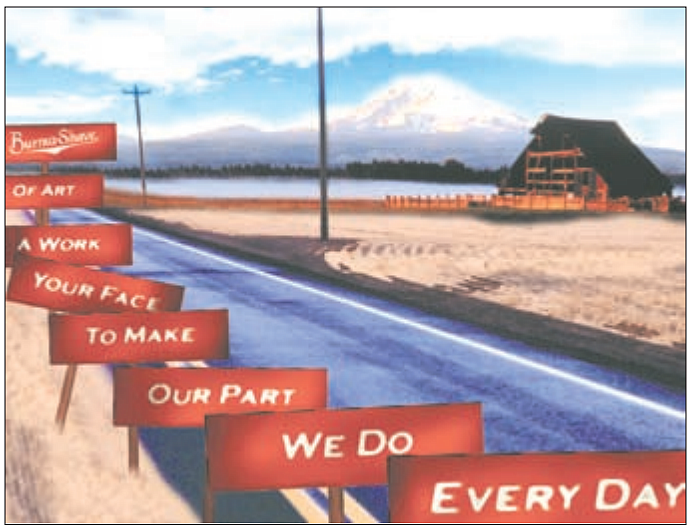The Verse By the Side of the Road
March 1, 2024 at 8:05 p.m.
Many remember with fondness the Burma-Shave signs that once stretched along America’s rural highways and byways
...by Chuck Woodbury
Back in the day, long before Northwest Prime Time switched from print to online-only, fellow local publisher, Chuck Woodbury of RVTravel.com, graciously provided permission to reprint his article about Burma-Shave. Here it is for your reading pleasure. Thanks again, Chuck Woodbury.
Once, long ago, cars went slow and “super” highways were two lanes. One of the joys of driving back in those good ol’ days was reading the Burma-Shave signs by the side of the road.
O ne after another, they told a little upbeat story, all with the punch line “Burma-Shave."
For those too young to remember Burma-Shave, it was a brushless shaving cream. Today, anyone older than 65 fondly remembers the red and white signs that advertised the product along America’s rural highways and byways. On a nondescript stretch of road, where the best scenery might be a pasture with cows, the sight of Burma-Shave signs ahead was reason for celebration—the monotony was broken.
Grandpa’s Beard
Was Stiff and Course
And That’s What Caused
His Fifth Divorce.
Burma-Shave.
The first Burma-Shave signs debuted along the American roadside in 1926 in Minnesota, home of the Burma-Vita factory. They were hardly impressive.
“We lettered them rather crudely, and tested them on two highways,” said Leonard Odell, the younger brother of Allan Odell, who conceived the signs as a way to advertise the then little-known shaving cream. “The first batch didn’t even rhyme.”
At first, the signs were purely a sales pitch. But soon they found their sense of humor, sometimes including a safety message. Signs were most often clustered in a set of five or six, placed 100 feet apart, each offering a single line of a jingle. At 35 miles per hour, it would take a motorist about 18 seconds to read a message from start to finish.
At the height of the signs' popularity, about 7,000 stretched across 45 U.S. states. Families who drove past would often read them aloud, soon developing favorites. The upbeat messages cheered travelers during the otherwise bleak Depression years and then again later during World War II.
Special Seats
Reserved in Hades
For Whiskered Guys
Who Scratch
Their Ladies.
Burma-Shave.
The signs catapulted the tiny Burma-Vita Corporation into a household word. Little known even today is that the company never had more than 35 employees, yet it was perceived as a corporate giant.
Employees either worked in production at the Minneapolis factory or in the field erecting signs. Yet even the road crews never exceeded more than eight vehicles. Crew members were called PhDs, short for “post hole diggers.”
But as cars got faster and roads evolved into wide superhighways, Burma-Shave signs lost their effectiveness. In 1963, the Phillips Morris Company bought Burma-Vita. The last sign was pulled from its stakes three years later.
And as you might expect, as the signs went down so did sales of Burma-Shave. And like the signs, they never went back up.
Chuck Woodbury has explored America by RV for nearly three decades. In the ‘90s he published a quirky travel newspaper about his adventures and was an “on the road” writer for the New York Times Syndicate. Nowadays, he lives in Edmonds where he operatesRVtravel.com .
Grandpa’s Beard
Was Stiff and Course
And That’s What Caused
His Fifth Divorce.
Burma-Shave.
“We lettered them rather crudely, and tested them on two highways,” said Leonard Odell, the younger brother of Allan Odell, who conceived the signs as a way to advertise the then little-known shaving cream. “The first batch didn’t even rhyme.”
At first, the signs were purely a sales pitch. But soon they found their sense of humor, sometimes including a safety message. Signs were most often clustered in a set of five or six, placed 100 feet apart, each offering a single line of a jingle. At 35 miles per hour, it would take a motorist about 18 seconds to read a message from start to finish.
Special Seats
Reserved in Hades
For Whiskered Guys
Who Scratch
Their Ladies.
Burma-Shave.
The signs catapulted the tiny Burma-Vita Corporation into a household word. Little known even today is that the company never had more than 35 employees, yet it was perceived as a corporate giant.
Employees either worked in production at the Minneapolis factory or in the field erecting signs. Yet even the road crews never exceeded more than eight vehicles. Crew members were called PhDs, short for “post hole diggers.”
But as cars got faster and roads evolved into wide superhighways, Burma-Shave signs lost their effectiveness. In 1963, the Phillips Morris Company bought Burma-Vita. The last sign was pulled from its stakes three years later.
And as you might expect, as the signs went down so did sales of Burma-Shave. And like the signs, they never went back up.
Chuck Woodbury has explored America by RV for nearly three decades. In the ‘90s he published a quirky travel newspaper about his adventures and was an “on the road” writer for the New York Times Syndicate. Nowadays, he lives in Edmonds where he operates





